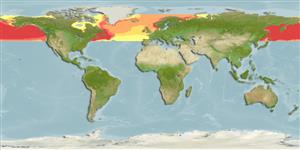Common names from other countries
分類 / Names
俗名 | 同種異名 | Catalog of Fishes(屬, 種) | ITIS | CoL | WoRMS | Cloffa
Teleostei >
Osmeriformes (Freshwater smelts)
胡瓜魚目 (Freshwater smelts) >
Osmeridae (Smelts)
胡瓜魚科 (Smelts)
Etymology: Osmerus: Greek, osme = odorous; similar to freshly cut cucumbers (Ref. 45335); mordax: mordax meaning biting (Ref. 10294).
More on author: Mitchill.
Environment: milieu / climate zone / depth range / distribution range
生態學
海洋; 淡水; 半鹹淡水; 溯河洄游 (Ref. 51243); 深度上下限 0 - 425 m (Ref. 58426), usually ? - 150 m (Ref. 96339). 溫帶; 6°C - 18°C (Ref. 1998); 73°N - 41°N, 167°W - 53°W (Ref. 86798)
North Atlantic: Atlantic drainages from Lake Melville in Newfoundland and Labrador, Canada to Delaware River in Pennsylvania, USA and west through Great lakes. Arctic and Pacific drainages from Bathurst Inlet, Northwest Territories to Vancouver Island in British Columbia, Canada. Also Pacific drainages of Asia.
北大西洋: 湖梅爾維爾, 拉布拉多在加拿大對德拉瓦河,賓州,(也許到維吉尼亞), 與在內陸沿著聖徒勞倫斯河對秀克必李耳湖。 西北太平洋: 外海的俄國.(參考文獻 26334)
Length at first maturity / 大小 / 重量 / 年齡
Maturity: Lm 19.5 range ? - 19.8 cm
Max length : 35.6 cm TL 雄魚/尚未辨別雌雄; (Ref. 1998); 最大年齡: 7 年 (Ref. 52222)
背棘 (總數) : 0; 背的軟條 (總數) : 8; 臀棘: 0; 臀鰭軟條: 12 - 16; 脊椎骨: 58 - 70. Body elongate, laterally compressed, greatest depth at anterior of dorsal fin origin. Head moderate; eye moderately large; snout elongate, pointed. Mouth large; lower jaw protruding, maxillary extending to middle of eye or beyond, well toothed on vomer, palatine, pterygoid, basibranchial, dentary, maxillary, and tongue. Teeth specially enlarged on tongue and front of vomer. Body color is pale green on back, with purple, blue, and pink iridescent reflections on the side when freshly caught.
細長的身體, 側扁的, 最大的高度在前面的背鰭起點。 頭部中等的; 眼普通大的; 吻延長, 尖的。 嘴大的; 下頜凸出, 上頜骨延伸至眼的中央或者超過, 在犛骨上有相當多齒的, 上顎的﹐翼狀的, 基鰓骨,齒骨,上頜骨與舌。 齒特別地在舌與犛骨的前面上增大了。 體色是灰綠色背面, 藉由紫色的﹐藍色的﹐與粉紅的彩虹色的反光側邊上當新捕捉。
Nerito-pelagic (Ref. 58426). Inhabits cool clear lakes, medium to large rivers, and coastal waters (Ref. 86798). A schooling species that occurs in midwater of lakes or inshore coastal waters (Ref. 1998); at temperatures ranging from 7.2-15.6°C. Coastal population are anadromous (Ref, 86798). Migrates up to 1,000 km upstream in rivers (Ref. 6793). Occurs possibly to 425 m (Ref. 2851). Feeds on invertebrates such as amphipods, ostracods, aquatic insect larvae and aquatic worms (Ref. 1998); food also include copepods, euphausiids, mysids and small fishes (silversides, mummichogs and herring) (Ref. 5951, 10294). Headed, gutted, sold fresh, frozen and precooked. Eaten sautéed and fried (Ref. 9988).
沿海-大洋性.(參考文獻 58426) 一個群游性魚種出現於湖或沿海地區沿岸水域的中層水域中;(參考文獻 1998) 溫度範圍從 7.2-15.6個 ° C. 在河中向上迴游到 1,000個公里上游。 (參考文獻 6793) 可能地對 425 公尺生存。 (參考文獻 2851) 吃無脊椎動物例如片腳類動物,介形蟲, 水生的昆蟲幼生與水生的蠕蟲;(參考文獻 1998) 食物也包括橈腳類的動物,磷蝦,糠蝦與小魚 (銀漢魚, mummichogs 與鯡魚) 。 (參考文獻 5951,10294) 帶領, 腸道, 賣.生鮮地, 凍結而且預煮。 被吃炒而且油炸。 (參考文獻 9988)
Spawning runs occur when temperature is between 8.9-18.3°C, may last for 3 weeks, peak for 1 week. Lengths of both sexes decrease as spawning progress. Two or more tuberculated males maintain position against a female in swift water, eggs released in clusters and presumably milt released simultaneously. Spawning usually takes place at night, spawners move downstream to the lake during daytime. 北大西洋: 湖梅爾維爾, 拉布拉多在加拿大對德拉瓦河,賓州,(也許到維吉尼亞), 與在內陸沿著聖徒勞倫斯河對秀克必李耳湖。 西北太平洋: 外海的俄國.(參考文獻 26334)
Mecklenburg, K.C., P.R. Møller and D. Steinke, 2011. Biodiversity oif the Arctic marine fishes: taxonomy and zoogeography. Marine Biodiversity 41(1):109-140. (Ref. 86838)
CITES (Ref. 128078)
Not Evaluated
人類使用
漁業: 商業性; 游釣魚種: 是的
工具
特別的報告
下載 XML
網路資源
Estimates based on models
Preferred temperature (Ref.
115969): 0.2 - 6.9, mean 2.7 (based on 724 cells).
Phylogenetic diversity index (Ref.
82804): PD
50 = 0.5625 [Uniqueness, from 0.5 = low to 2.0 = high].
Bayesian length-weight: a=0.00407 (0.00328 - 0.00506), b=3.15 (3.08 - 3.22), in cm Total Length, based on LWR estimates for this species (Ref.
93245).
營養階層 (Ref.
69278): 3.0 ±0.0 se; based on diet studies.
回復力 (Ref.
120179): 中等的, 族群倍增時間最少 1.4 - 4.4年 (K=0.31; tm=2-6; tmax=6; Fec=8,500).
Fishing Vulnerability (Ref.
59153): Moderate vulnerability (38 of 100).
Climate Vulnerability (Ref.
125649): Low to moderate vulnerability (32 of 100).
